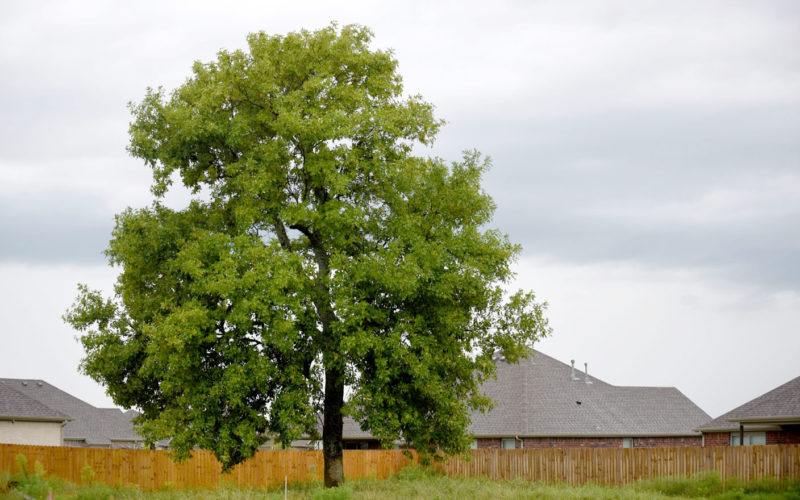City trying to balance growth versus tree preservation
STACY RYBURN
sryburn@nwadg.com
Fayetteville city employees are trying new ways to monitor and preserve the tree canopy in the face of rapid development.
Urban foresters agree the city is losing tree canopy every year, they just aren’t sure how much. Trees planted this year to mitigate the ones cut down will take a decade to grow large enough to cover the same area, they say.
Urban tree canopy refers to the coverage of tree branches and leaves when viewed from above.
The city needs to know what the problem is to fix it, said John Scott, one of the city’s two urban foresters. The method to track trees lost and replaced because of new development changed this year. From 2016 to 2018, foresters used information from the city’s review of a development before any work at the site happened.
Foresters realized a project might be sorted out on paper, but never actually develop, or develop differently from the plans. This year, they started tracking trees associated with grading permits, giving them a more accurate picture, Scott said. A grading permit allows a developer to break ground on a project.
Before 2015, when Scott started, the city didn’t keep track of trees lost and mitigated in new developments. An outside consultant put together an assessment of the urban canopy in 2012, covering information from the year 2010. The report found the city had 36% coverage.
Last year, foresters found they could get information from the National Agriculture Imagery Program, which surveys the city in odd-numbered years. Using satellite imagery, the foresters can get an accurate picture of the canopy on the ground, Scott said.
Information from the 2017 national program showed a 35% tree canopy, down 1% from the 2012 report. However, the two data sets use different methods, so it’s like comparing apples to oranges, Scott said. The city should have the information available from the national program from 2011 this month and will be able to compare it to the 2017 data, he said. Information for this year won’t be available until next year.
The goal is to have 40% tree canopy. Getting information from the national program for several years will help the city take a precise approach in its tree preservation and mitigation practices, Scott said.
“With this information, we can figure out exactly how many trees we need to plant to reach our goal,” he said. “From there, we can set long-term goals.”
Current conditions
The city adopted its tree ordinance in 1993. It’s had several adjustments over the years, but sets standards for developers to follow when building new projects. Each zoning designation has a percentage of tree canopy developers must preserve.
The foresters sometimes hold a pre-development meeting on projects to go over any obvious issues. The developer then submits a plan to Technical Plat Review, where foresters review the project and provide comments. The project then might go to the Subdivision Committee of the Planning Commission, then the full Planning Commission, depending on the scope of the project and if any variances to city code are requested.
Foresters also review final construction plans before the project breaks ground.
Contractors are required to put fencing around trees that aren’t supposed to be cut down. The policy has been to use plastic orange fencing most of the time, or a chain-link fence in certain instances. On Aug. 14, the Urban Forestry Advisory Board recommended the opposite — using chain-link fence most of the time, which is harder to move.
After construction starts, the foresters’ involvement becomes complaint-driven. They can put a stop-work order on any project found in violation of the tree preservation requirements. Crews on site are given remediation techniques to correct any damage done, and the foresters return to see if the instructions were followed before lifting the stop-work order.
Issuing a stop-work order has proven effective, said Melissa Evans, the city’s other urban forester. However, for any developer who continuously ignores the ordinance, that’s the end of the recourse, she said.
“That usually gets their attention pretty quick, because they’re under tight deadlines and time is money,” she said. “But, unfortunately, that’s about all we can do.”
Zoning designations have a certain percentage of required tree canopy preservation that can vary from 10% to 30%. There’s a calculation for the number of trees that must be planted if the project removes more than the percentage minimum.
The math doesn’t check out, said Garner Stoll, the city’s development services director. If the highest preservation goal is 30%, and a developer decides to maximize the removal, then a property is guaranteed to lose 70% of its canopy, he said.
That’s why planting new trees, where there were none before, is so important to reach the 40% goal, Stoll said. “If preservation is our only strategy, we have a losing strategy,” he said.
City planners are discussing changes to code to bolster canopy coverage, but there’s a balance to strike, Stoll said. Raising the tree preservation requirements, for instance, could cause buildings to be oddly located on a property. Planners try to encourage sound urban strategy, with a building’s orientation to sidewalks, streets and other buildings conducive to walkability and transit, he said.
Preserving every tree would spread development throughout the city, contributing to urban sprawl, Stoll said. But trees are critical to urban planning, he said.
Canopy keeps temperatures down in the heat of the summer and breaks the wind blowing during cold months, Stoll said. That reduces air-conditioning costs. Walking becomes more comfortable. Trees create a more livable environment, he said.
The city not only needs compliance from developers, but resident participation as well, Stoll said. Programs such as the city’s annual Celebration of Trees provide free trees to anyone who wants them.
“It takes the whole village to meet our planning goals,” he said. “We can plant trees, we can require the developers to plant trees — they do it on their own, too — but it takes all the property owners to reach our canopy goals.”
Other measures
Old, large trees especially should be protected, former Mayor Dan Coody said. Coody has a large pecan tree behind his property at 215 N. East Ave. that he became concerned about. A restaurant going in on the other side of his fence on Block Avenue had dug a hole in the ground that exposed some of the roots. Coody raised his concern to the urban foresters, who issued a stop-work order and gave the contractors instructions on how to rectify the situation.
It’s one thing to talk about being a city that recognizes the importance of trees, but another thing to put good policy into practice, Coody said.
New road projects, such as on Old Wire, don’t have adequate street trees included in their plans, he said. Inappropriate types of trees get planted for mitigation such as elms under power lines or crabapples without adequate width, he said. Trees planted by the city, such as along College Avenue, get trimmed by tractor-trailers instead of having proper maintenance, he said.
Making the code more specific, adding staff to enforce the tree ordinance and implementing more protections for larger, older trees would show the city is serious about preserving and growing the canopy, Coody said. That clear message would prompt developers to be more mindful about the trees on their properties, he said.
“I see where we rest on our laurels too much, and we’re kind of like, ‘Well, isn’t it too bad that we’ve got to lose this canopy, but gee, growth is important,’” Coody said. “To me, the aesthetic and the environmental qualities that trees give should be just as important as the rest of our infrastructure.”
Having a 40% urban canopy goal is a good standard, said Krista Quinn, urban forestry program coordinator with the Forestry Division of the Arkansas Department of Agriculture. The state has a 58% canopy cover. Little Rock had a 48% canopy cover in 2013, per the division’s assessment then. So, the goal is doable, she said.
The division isn’t sure how many cities in Arkansas have tree ordinances, and ordinances can vary widely for the ones that do, Quinn said. Few cities monitor their tree canopy closely, she said.
“There are many different ways to monitor canopy cover, and some of them are quite detailed and expensive,” Quinn said.
Bentonville’s ordinance only protects trees in the right of way, said Danielle Semsrott, senior planner. The city holds tree plantings and giveaways and issues awards or credits to developments that go beyond requirements.
Like Fayetteville, Bentonville has regulations in place to spur tree planting and preservation at the time of development. Violations are complaint-driven, and the city’s code enforcement officers review complaints, Semsrott said. Bentonville does not have urban foresters on staff.
An urban tree canopy assessment for Bentonville had the city at 25% coverage in 2013, with a goal of 35%. The city hasn’t had an assessment since, but Semsrott said she suspects the canopy is about the same today.
“Hopefully all the efforts we put into new tree plantings — hopefully that has made a difference,” she said.
Rogers requires replacement trees be planted if a certain number of significant trees are removed, said Ben Cline, city spokesman. There’s a 1-to-5 ratio for development, he said. Developers also can get credits for preserving existing trees.
Springdale does not have a tree ordinance.
Will Dockery, chairman of Fayetteville’s Urban Forestry Advisory Board, said the city should do more to preserve large, old trees. Large trees sequester more carbon, provide more shade, have a greater cooling effect than younger trees and better protect from flooding, among other benefits, he said.
The board has considered adding age into city code, but more than anything, large trees should be at the forefront when planning a new development, Dockery said. The result may be funkier than if all the trees were cleared, but being funky is what Fayetteville is known for, he said.
Development and tree preservation don’t have to be exclusive ideas, Dockery said. Tree canopy is a shared resource, he said.
“We don’t want to prevent people from making money or building the things they want to build on their property,” Dockery said. “We just want to make sure we’re thinking of the future and thinking of not only ourselves, but our neighbors, too.”
__
FAQ
Celebration of Trees
WHEN — 7 a.m. Oct. 26
WHERE — Arvest Plaza, downtown Fayetteville square
WHAT — Two free trees available per resident. Proof of residency is required.
__
FYI
Web Watch
Read Fayetteville’s tree ordinance:
bit.ly/faytreeordinance






